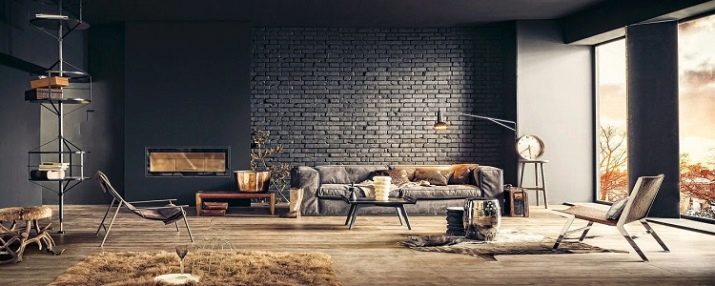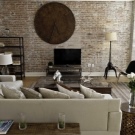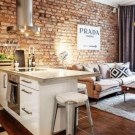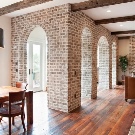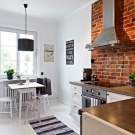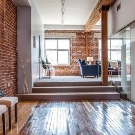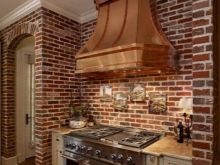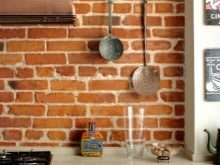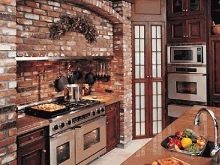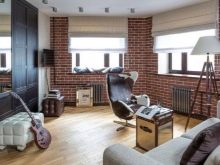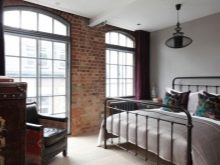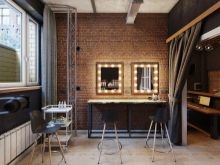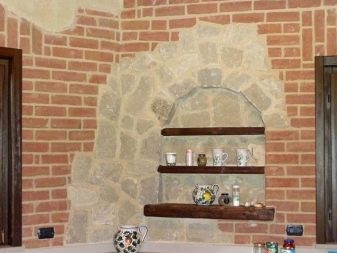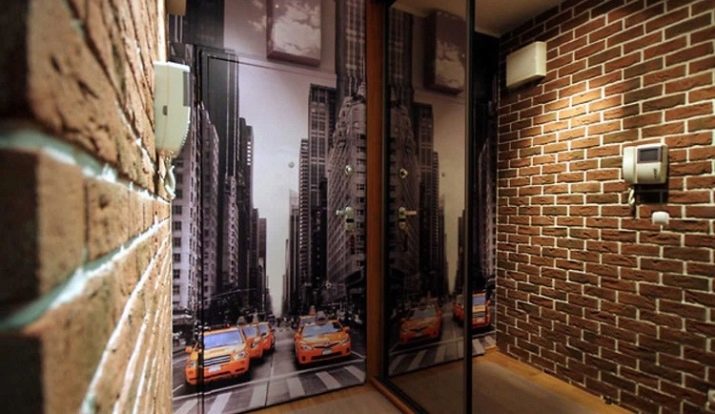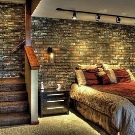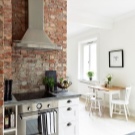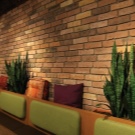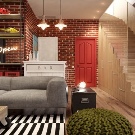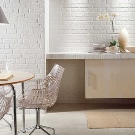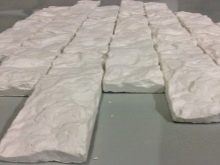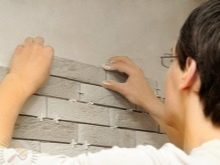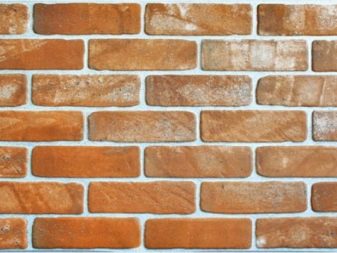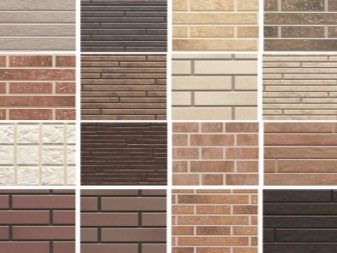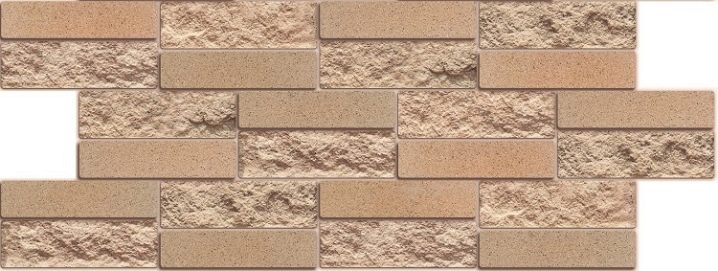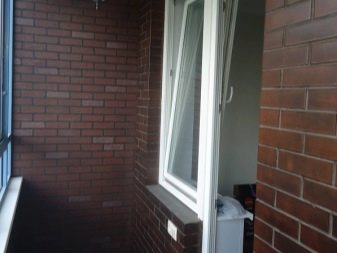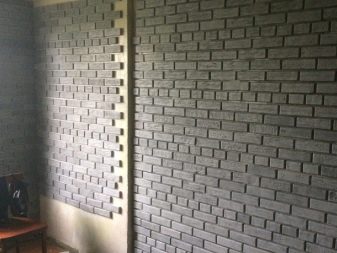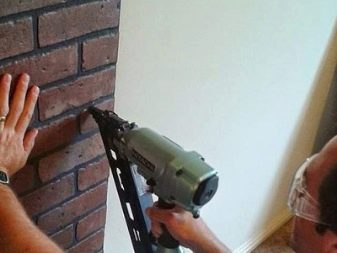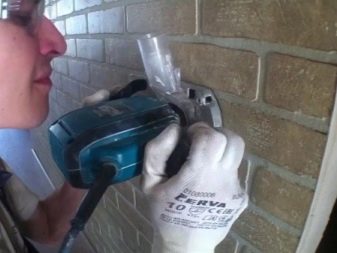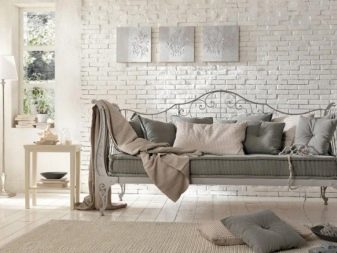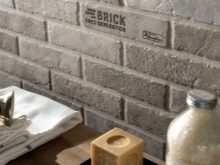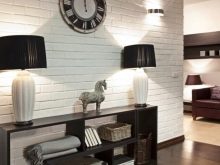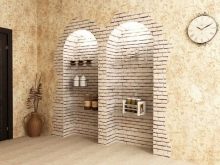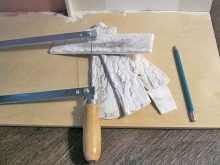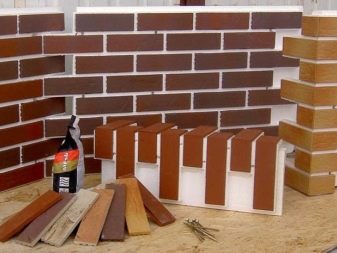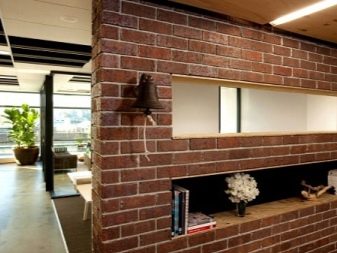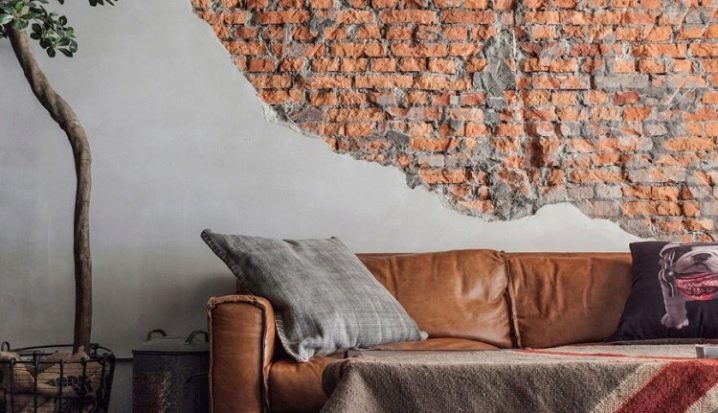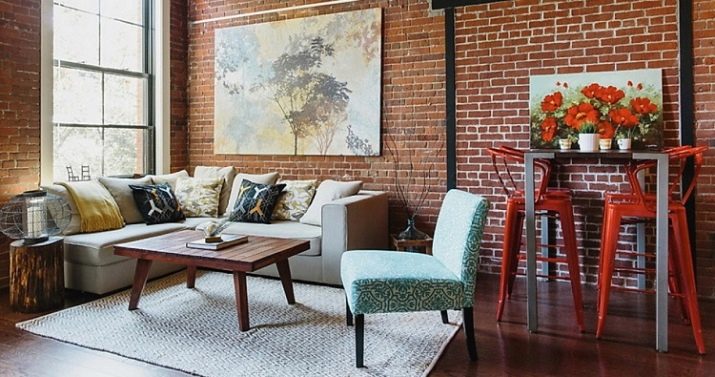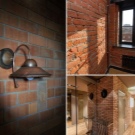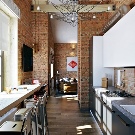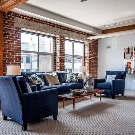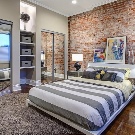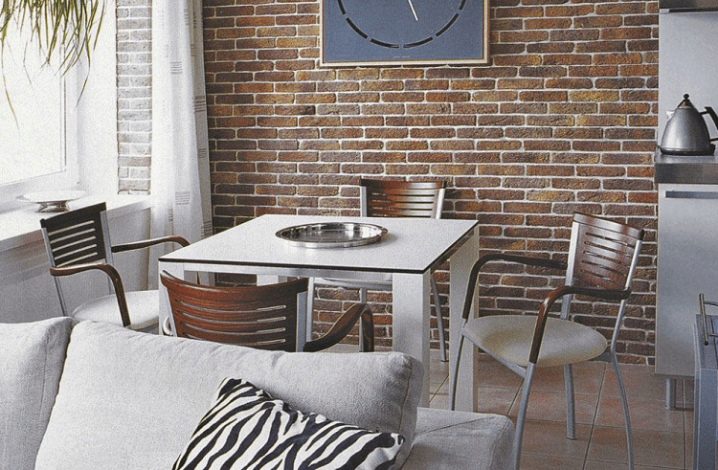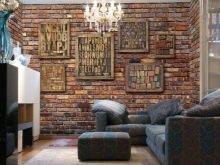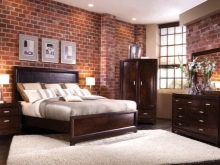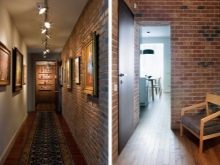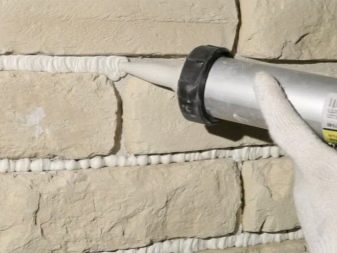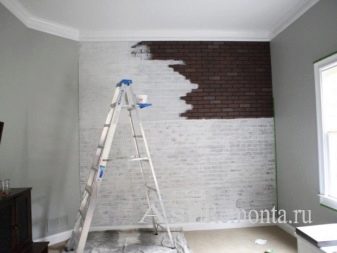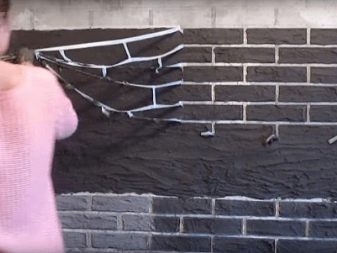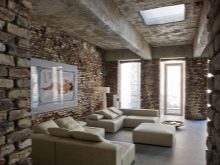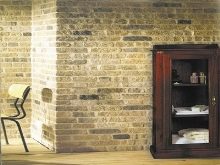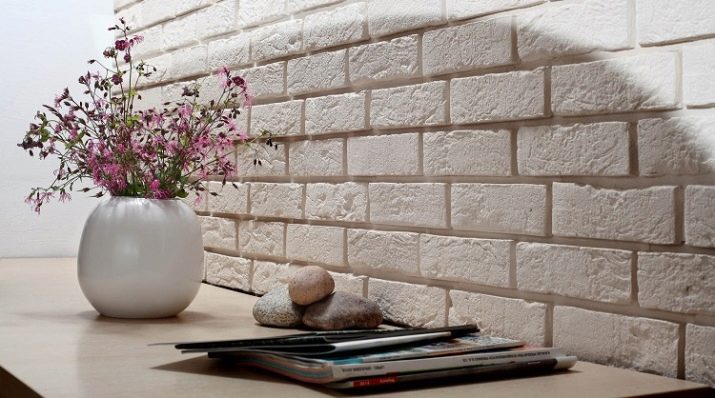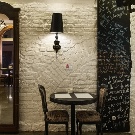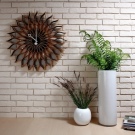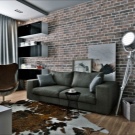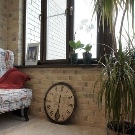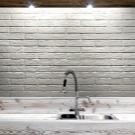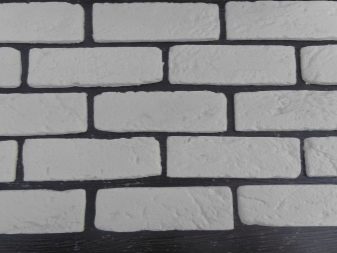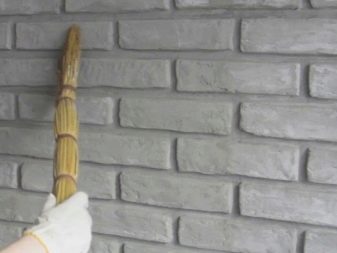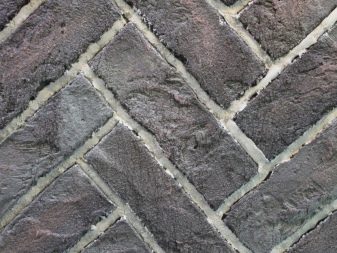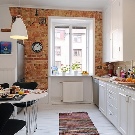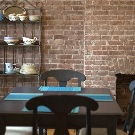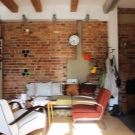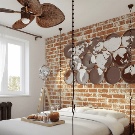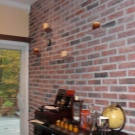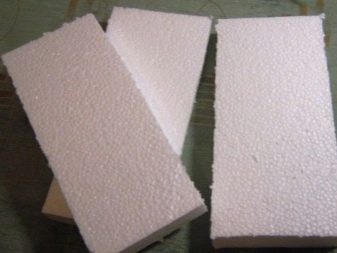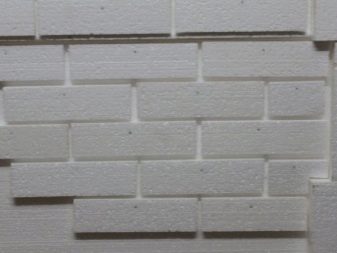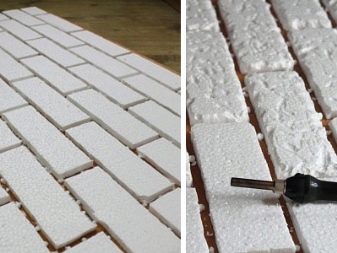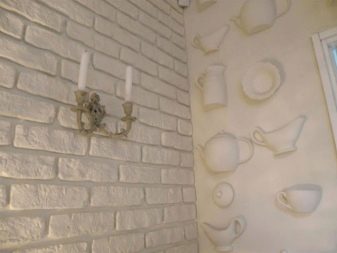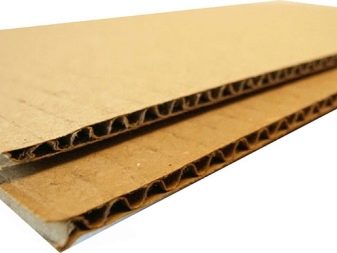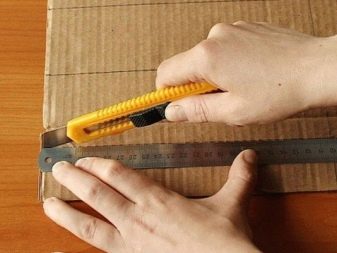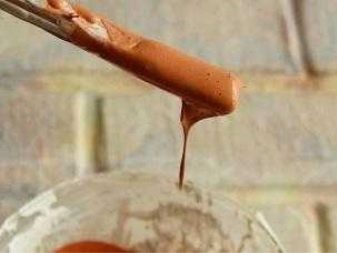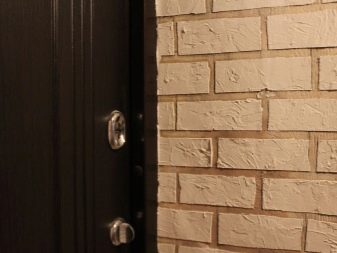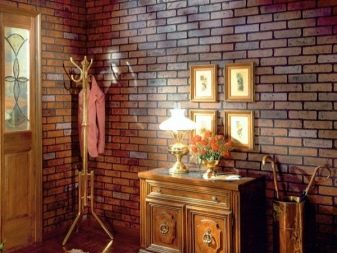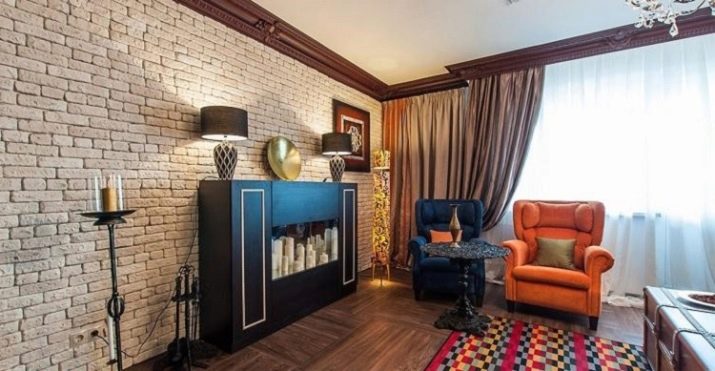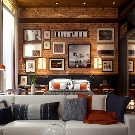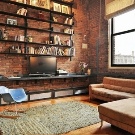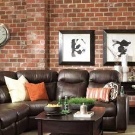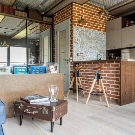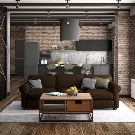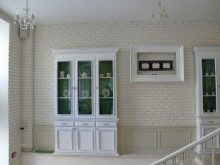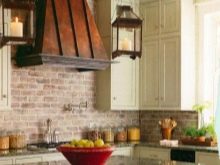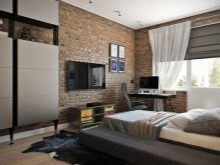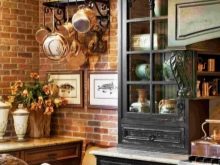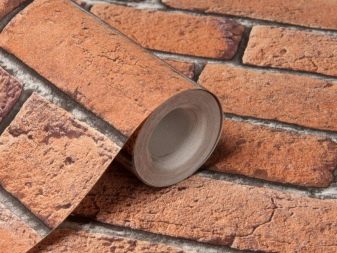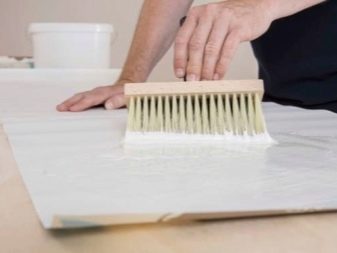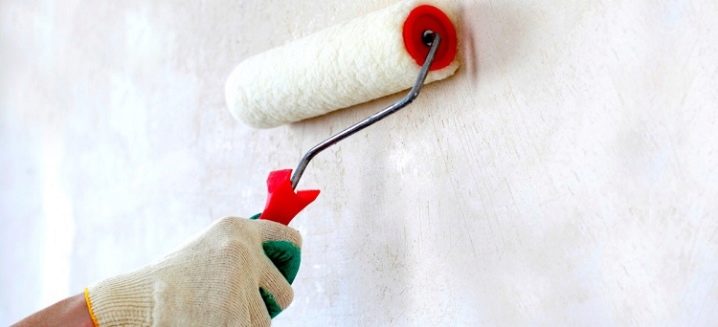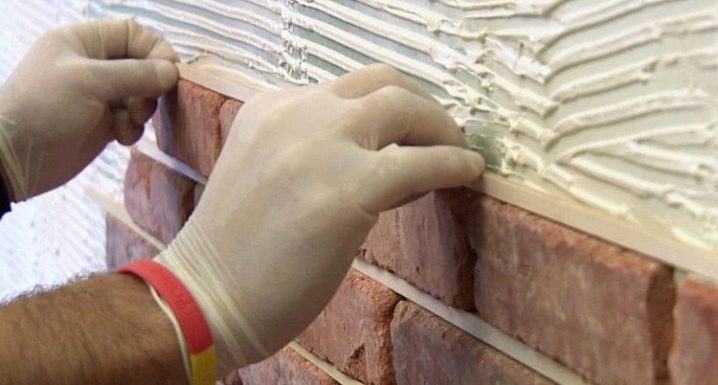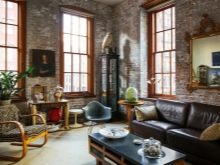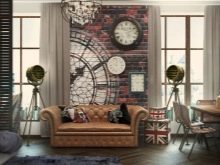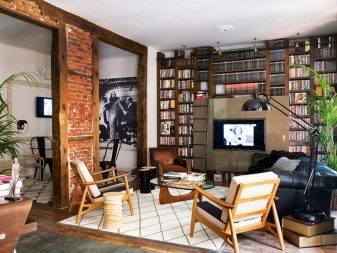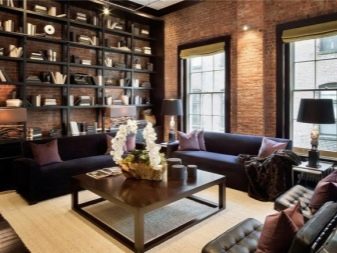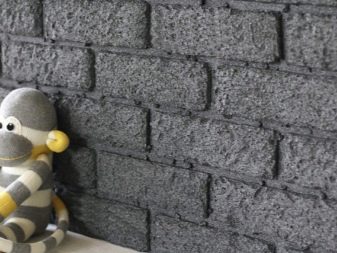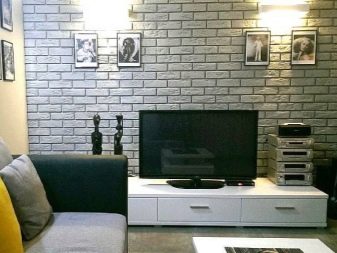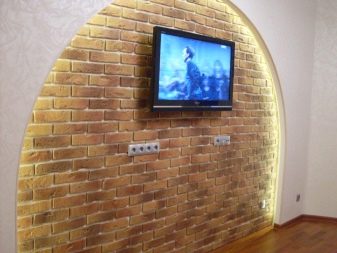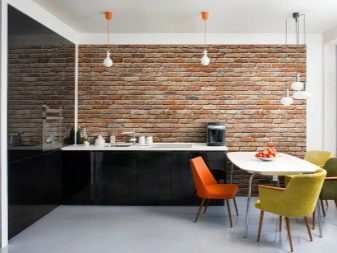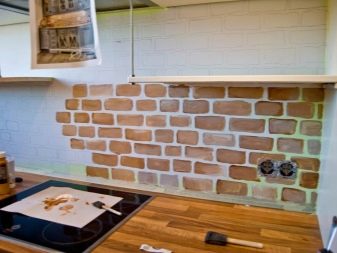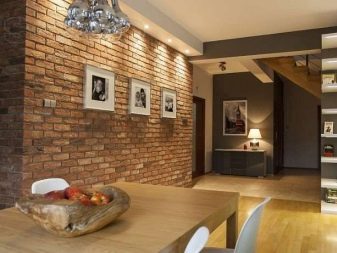Features and manufacture of imitation bricks for interior decoration
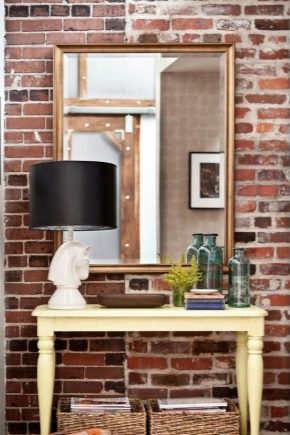
Brick is a fairly popular finishing material and harmonizes with many interiors. However, the use of this stone is not always possible for a number of technical and material reasons.
In this regard, the imitation of the walls under the brick has found wide application and is actively used in the decoration of hallways, kitchens, fireplace halls and living rooms.
Special features
Imitation brickwork has obvious advantages over natural brick. First of all, this is a significant saving of time and money.Ceramic and clinker bricks are quite expensive materials and wall decoration, made with their help, will be quite expensive. In addition, during the formation of brickwork it is necessary to use cement mortar, which significantly increases the cost of repairs and leads to the formation of large amounts of dirt and dust.
No less important advantage of imitation "under the brick" is the lack of load on the foundation. For the design of “brick” surfaces, as a rule, light and thin materials are used, whose presence does not affect the supporting wall and does not weigh down the structure.
The use of decorative coatings, unlike natural bricks, does not create a greenhouse effect and does not require coordination in the BTI. In addition, finishing takes very little time and can be done independently.
Materials
Imitation of brickwork is carried out by different methods using modern materials. Many options for decorative cladding do not require building skills and can be made by hand, while working with real bricks should be performed only by professionals.The simplest and most affordable finishing options are finished coatings with a brick pattern already applied to their surface. They can only cut to size and stick. These materials include wallpaper and wall panels.
Wallpapers "under the brick" have a convex texture, fully repeating the relief of the brickwork. This option is the fastest and most inexpensive way to transform a room. "Brick" wallpaper looks good in kitchens, hallways, corridors and halls. High decorative properties of the material due to the use of modern technology, thanks to which it became possible to very accurately simulate the roughness and flaws of this brick. Wall-paper is the ideal solution for finishing small-sized rooms: despite the relief, they remain the thinnest finishing material and do not reduce the space by a centimeter.
To give a volumetric masonry more natural look, designers advise to combine wallpaper with gypsum bricks. Usually, gypsum is trimmed with corners and doorways, which, in combination with the bricks on the wallpaper, looks very harmonious.The advantages of such finishes include good ventilation of the wallpaper, thanks to which the wall is able to breathe. There is a minimum amount of dust and debris during installation, as well as environmental friendliness of the material. The disadvantages include low water resistance and a tendency to accumulate dust between the “bricks”. This imposes certain restrictions on the use of wallpaper and does not allow their use in bathrooms and kitchens.
Wall construction panels "under the brick" are sheet finishing material with a relief texture applied to it. The panels are available in two versions. The first type is represented by plastic models made of PVC and capable of withstanding conditions of high humidity and high temperatures. The latter are MDF sheets, for the production of which wood chips are pressed under high pressure.
However, despite the sawdust base, the products are characterized by high moisture resistance and heat resistance. This is due to the presence of decorative and protective layers, which makes it possible to use MDF models for wall decoration in kitchens and on balconies.
Sheet panels are produced in standard dimensions 244x122x0.6 and 320x244x0.6 cm, and, if necessary, are cut to size. In addition, they have a low weight and create a minimum weight load on the supporting structures. Fastening sheets to the walls is carried out with the help of nails, screws and screws, and the installation is carried out in two ways. In the first case, the models are mounted directly on the wall, and in the second they require the installation of a batten.
The advantages of the panels include flawless appearance and long service life. The imitation of the bricks on their surface is so natural that from a certain distance it is taken for a real laying. The undoubted advantage of the use of sheet material are its excellent sound insulation properties. This allows you to slightly reduce the audibility of neighboring rooms, which is especially important for homeowners in panel houses.
Also among the advantages of building panels include resistance to the effects of acids and alkalis, no risk of mold and mildew and ease of maintenance. The panels are sufficiently maintainable, which makes it easy to replace a damaged element without dismantling the entire lining.In addition, the material has a low cost and is available in a wide range of colors, designs and textures.
However, along with the obvious advantages, the material also has disadvantages. The disadvantages include the need for crates, which entails additional costs, as well as the associated reduction in the usable floor space, which is especially noticeable in narrow corridors and small hallways.
The next group of materials is distinguished by high decorative qualities, and, in contrast to wallpaper and building panels, has a stronger similarity with brickwork. These materials include tile, decorative plaster and plaster.
The tile imitating a decorative brick is practical and inexpensive material. Products differ in small weight and do not exert a significant load on the foundation. The material for the manufacture of tiles "under the brick" are gypsum, refractory clay and artificial or natural stone. Gypsum and clinker models are more used for interior decoration, while stone products are widely used in exterior cladding.
The brick tile is the most popular finishing material and differs in the high durability and full identity with a ceramic brick. This is explained by the fact that, in its composition and production technology, clinker tiles are the real clinker bricks, with the only difference that the width of a standard brick is 12 cm, and the width of a tile is 10 mm. Along with the traditional models, there are products of the so-called "manual molding", having a rough surface with ruts and allowing to form a "antique" brickwork. The edges of such tiles are uneven and slightly chipped, which makes the products very similar to the material of a century ago.
Clinker models are ideal for most modern styles, such as loft, techno, metallic and high-tech. The material is resistant to aggressive external factors, and therefore can be used in humid and hot rooms. In addition, clinker tolerates the effect of any detergent, so it is often used in kitchens.
Gypsum tile is the most budget and environmentally friendly finishing option. Gypsum is characterized by low weight, wide consumer availability and ease of installation. Thanks to a simple manufacturing process, tiles can be made independently using plaster and a special silicone mold. The material is well suited for spot mounting, when it is necessary to decorate a wall or an area near the doorway.
In such cases, the decoration of the walls occurs with the help of individual bricks or combinations consisting of several pieces. Tiles made of natural or artificial stone are more often used for exterior facades, but the material looks quite good in the interiors of the fireplace areas and halls of public spaces.
The advantages of facing tiles "under the brick" are considered excellent thermal insulation properties, which is explained by the high porosity and low thermal conductivity of products. In addition, the material rather naturally imitates a real brick, and in the case of clinker models it is generally indistinguishable from the prototype. The advantages include a wide range, represented by a wide variety of textures and shades, as well as excellent performance characteristics of the tile and its long service life.
Among the minuses there is an increased water absorption of the material, which is explained by high porosity and imposes a number of restrictions on its use. For example, unglazed models are not recommended for use in kitchens and bathrooms: tiles very quickly absorb moisture and begin to fall off.
Brick veneers are a variety of tiles and are represented by individual elements made of plastic, wood, leather, glass and polystyrene foam. These "bricks" are sold individually and are ideal for spot decoration of small interior areas or individual sections of the wall. "Bricks" have a very small weight, so they can be mounted directly on the wall with glue. To give the masonry effect "antique" elements give a natural rubbing and make notches.
Decorative plaster is a spectacular facing material and is widely used to imitate brickwork in interior decoration of walls. The advantages of this type of lining is a large variety of textures and shades, simple installation, long service life and high heat and sound insulation properties of the coating.
Wide consumer accessibility and ease of use of the material allow you to create brickwork yourself. Plaster is absolutely safe for the health of others and can be safely used in residential areas.
However, as with any other material, plaster has its weaknesses. These include the tendency of the decorative layer to accumulate dust and the demands on the working surface during installation. In the course of the preparatory work, the walls must be leveled and plastered, otherwise even minor defects will be clearly visible on the floor, and the appearance of the wall will be damaged.
Gypsum brick imitation is the most affordable way to decorate. Working with gypsum does not require professional skills and the use of special equipment. To create an imitation of brickwork, you only need to apply a plaster mortar to the wall and draw lines with your finger that define the boundaries of the “bricks”. Then you need to wipe the notches with cement mortar, and paint the “bricks” themselves in the desired color.
Advantages of the method is considered low cost of consumables and the possibility of implementing bold colors.The disadvantages include the need for too long and painstaking work, which is to carefully coat the seams and paint each brick.
The following three methods of wall cladding involve the independent manufacture of bricks and allow you to decorate a room cheaply and stylishly. The easiest way to finish is painting the wall "under the brick." To do this, it is enough to have a flat surface, a roller, a brush and paints. The best option for painting walls is an elastomeric paint, due to its ability to fill all small cracks and protect the surface from moisture.
However, in its absence, the use of acrylic enamel, and in extreme cases - water-based. The color of the brickwork is chosen in accordance with the general style of the room, however, it is better to give preference to the natural colors of the brick - red, brown and yellow. However, bright and eccentric colors are more suited to the interior, decorated in a loft style, and calm pastel colors would be more appropriate for country music.
The advantages of this method include ease of installation, low cost and wide consumer availability of materials.In addition, the smooth surface of painted walls is not prone to accumulation of dust and is easy to clean. Among the minuses can be noted a slightly rustic look, the risk of burning paint and the gradual loss of the attractiveness of the wall covering.
The second method of imitation brickwork involves the independent production of facing bricks from foam. This option will be the ideal solution when depicting an uneven tub. Foam blocks are practically weightless and can easily be mounted on thin partitions and non-capital walls. So, for facing plasterboard interior partitions foam plastic will be just a godsend. In addition to the decorative function, the material will play the role of heat and sound insulation and reliably protect the room from heat loss and extraneous noise.
Making bricks is a very simple process and does not take much time. To do this, just draw the same rectangles on the foam sheet and cut them with a stationery knife. Then blanks need to stick on the wall, then paint with acrylic paint and fluff the "seams".If the foam is not at hand, you can use the foam ceiling tiles. Such "bricks" do not fall apart when cutting and look much more accurate.
Likewise, you can make bricks of drywall or wood. These models will look good in the interior decoration of country houses when they design doorways and interwindow spaces. The advantages of foam bricks include the minimum cash costs and ease of manufacture. The downside is the fact that the foam masonry does not imitate a real brickwork very well and looks rather primitive.
The third way to design the walls "under the brick" is represented by the finishing of corrugated cardboard and is the cheapest option of all mentioned. Corrugated cardboard is the material used in the manufacture of boxes for food and household appliances. Usually it is stored in the backyards of retail chains and stores, which allows you to get such a box completely free of charge and minimize the cost of repairs.
In order to make bricks, it is necessary to disassemble the box, draw it into rectangles and cut the workpiece.Then the fragments need to be glued together, forming “bricks” of a certain thickness. Of course, it will not provide absolute similarity with brickwork, and it is most likely that it will not be possible to lay out a kitchen apron from it, but it is quite possible to realize unusual solutions and diversify the decor of the room.
Application in the interior
Despite the fact that brickwork is a fairly popular type of finish, it is not suitable for every room. The use of brick and its imitation looks good only in four styles: loft, country, hi-tech and English style. So, for apartments designed in the style of a loft, more suitable clinker ceramic tiles of red tones.
In order to soften some of the aggressiveness inherent in this direction, it is recommended to arrange natural wooden furniture in the room, to lay bright carpets and place flowering houseplants. However, with the choice of the latter you need to be extremely careful and not to use ivy and creepers. This is due to the fact that climbers add a sense of abandonment to the room and suggest dark thoughts.
The next interior direction, in which the use of brickwork is appropriate, is country. Rooms decorated in this style do not seem so gloomy as those of a loft, so it is often used to decorate bedrooms and living rooms. In addition, the premises, made in the style of country, are often equipped with wood-burning fireplaces, against which a textured brick will look very dignified. The use of bricks is also appropriate in high-tech style, suggesting the correct geometric shapes and proportions.
For the design of such spaces, light brickwork made in the corner zones, near doorways and windows is quite suitable. The brick in this case gives the room a somewhat businesslike style, so it can be used in offices and work rooms.
Also, brickwork is often used in rooms decorated in the English style. In such rooms, a “brick” focus is placed on the corners, the kitchen apron and the surrounding area. The brick looks good when finishing residential lofts and mansards, where, combined with such a coating like professional flooring, it can be used for techno and metal style.In addition, the imitation of brickwork can be used in the design of pillars and floor elements in the attic.
In whichever direction the room is decorated, it is very important that the brickwork is combined with interior items and furniture. Brick must be in harmony with plaster, wallpaper and lighting fixtures. Otherwise, the material will look something foreign and the new decoration will not give any pleasure.
Required tools
The choice of tools for finishing completely depends on the method of lining, as well as on the use of a particular material. In a universal set of tools and construction tools, it is necessary to ensure the presence of liquid nails, PVA glue, ruler, primer mixture, marker, alcohol and sponge. For the installation of clinker tiles, you will need a trowel and cement mortar, and when decorating walls with paint, you will need to stock up on a roller and stencil.
For self-production of "bricks" you will need a sharp construction knife, a small handsaw or a jigsaw and a set of sandpaper needed to create abrasions.If you intend to glue "brick" wallpaper, you will need a wide brush and a deep container for diluting the glue.
How to do it yourself?
Before you self-decorate the walls, you must carefully prepare their surface. To do this, completely free the wall from the protruding elements and remove the old coating. If potholes and chips are present on the basis, they are carefully smeared with cement mortar and rubbed over. After the wall is aligned, it must be treated with antiseptic and ground. The use of antibacterial compounds will help prevent the appearance of mold, fungus and bacteria.
When choosing a mixture for priming should be borne in mind that for each type of surface, it is desirable to use your own version of the primer. So, when treating concrete and cement walls, an acrylic blend will be suitable; for applying to wooden surfaces, it is better to use an alkyd compound, and glyphate and perchlorovinyl agents will be an ideal option for metal and brick foundations.
Acrylic compounds are a good basis for homemade bricks made of foam, wood and drywall. In the absence of professional primer compositions, you can use a solution of water and PVA glue. The priming of the walls is a very important stage of the cladding; therefore, this procedure cannot be neglected. Otherwise, the adhesive quality of the surface will be reduced and a reliable adhesion of the walls to the material will not be achieved.
Once the surface is aligned and primed, you can proceed to the installation of decorative coating. And if there is usually no problem with gluing wallpaper and installing panels of panels, then when installing individual elements, whether it be clinker tiles or homemade foam bricks, care must be taken and care must be taken. Imitation of brickwork should be carried out on a pre-marked surface, and the dimensions of cardboard or plaster bricks should correspond to the standard dimensions.
Thus, the traditional length of clinker models is 25 cm, and the height is 6.5 cm. Compliance with the size of the bricks, as well as the plausibility of the seams, will help to achieve maximum similarity with this masonry. When using clinker tiles, reinforcing mesh is often used, which provides better adhesion of the mortar to the wall and prevents the masonry from falling off.
However, in addition to sticking and decorating homemade bricks, there is a simple and affordable way to decorate, which is to use the technique of drawing on raw plaster. To perform it, you need to apply a layer of any plastering mixture or putty up to 5 mm thick to the wall. Then you need to take a plastic or rubber stencil and press it to the surface.
In order for the stencil to peel off the plaster well, it should be moistened with water before each application. When implementing this technology, the most important thing is to strictly observe the coincidence of horizontal lines and try not to lead the clutch up or down. After the “brick wall” is formed, the solution is allowed to dry, after which the surface is primed and coated with wax. The final step will be the coloring of the seams and the bricks themselves, which is best done with acrylic paints.
Beautiful examples in the interior
Imitation brickwork looks very impressive in many directions of interior design. The right choice of material and competent installation can revive any, even the most boring space, bringing a variety to the interior.
- Foam "bricks" in the hallway - stylish and inexpensive.
- Imitation of brick from decorative plaster in the living room interior.
- Registration area of the TV plasterboard.
- Photowall-paper in kitchen - an example of the practical and fashionable decision of registration of rooms.
- The surface of the clinker tiles is almost indistinguishable from a real brick wall.
- Drawn bricks look very cute and interesting.
In the next video you will find an imitation of stone and brickwork for interior decoration.
